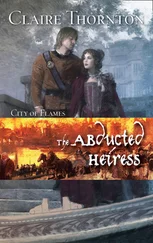Jack ducked into the closest ladder well and encountered two Coasties loping down single file.
“Wrong way, sir,” one of them called out.
“What?”
“Yah have to go to the starboard side if yah want to go up.”
The reasoning was immediately apparent as they squeezed past each other. Jack climbed to the bridge four levels up at the height of a six-story building. He stood and gaped at the view over the tip of Healy ’s bow and onto the slate-colored horizon. A crewmember approached and introduced herself as Ensign Sokolov. Stocky, formal but helpful, she offered a tour of the bridge that Jack gladly accepted.
The other crewmembers were all patient, and each took a moment to give their names, ranks, titles, and assigned tasks. They tried to explain various functions of a long control console with clunky buttons, lights, and radar screens. Captain Weber even walked over to give a handshake. He was tall and lean, like Jack, but with a chiseled profile that belonged on Mount Rushmore. His eyes were blue as worn denim, but unfocused with distraction. After excusing himself, the captain walked up to the windows of the bridge and lifted a pair of binoculars. He didn’t look out to the horizon but down at the dead eagles floating in the water.
Jack’s pager sounded. He pulled it from his waistband and squinted at the display.
“What’s this code mean?” he asked Ensign Sokolov.
“Abandon ship.”
“We’re still in the harbor!”
Her eyebrows lifted as she stated that safety drills were explained in the welcome aboard packet and his assigned emergency location was listed on his new passenger card.
“Yes, it is,” Jack agreed, pulling the card from his back pocket and using it to salute her.
The abandon ship locker was halfway up Healy ’s starboard side. A group of scientists were gathered by the doorway. Jack recognized the woman he had spoken with in the science lounge. She had light brown skin in the true light of day and barely came up to his shoulder in height.
“Might as well introduce ourselves,” Jack said, and approached with a smile.
He studied her oval face with rounded cheeks, nose, and chin. Her mouth had soft, mauve-colored lips, as if lightly stained by red wine. Sunglasses and gloves concealed her eyes and ring finger.
“Maya,” she said, after a pause. “Dr. Maya Gutiérrez. And this is one of my bunkmates, Dr. Nancy Stevens.”
She motioned to a tall woman standing beside her with paint-spatter freckles and red hair that curled and fluffed around her jawline.
“I’m Jack,” he said, shaking their hands. “Mr. Jack. Definitely not doctor.”
A Coastie holding a clipboard walked to the center of the group and called out above the wind.
“Good morning, life raft number five!”
They mumbled good morning and each raised their hands when he took attendance.
“Gustavo Wayãpi?”
Jack swiveled his head around but didn’t see his bunkmate.
“Gustavo Wayãpi going once? Going twice?”
The Coastie made a mark by Gustavo’s name. After roll call, he explained Healy ’s abandon ship procedure: what supplies each individual had to bring along, what to wear, and how food would be rationed. Jack scrolled through his email, trying not to count all the new messages from his mother. He was subtle, but the Coastie was watching his audience carefully.
“You gonna remember all this?” he asked Jack.
“It’s okay,” Jack assured him. “I can’t die. I’m an only child.”
The man wasn’t amused.
“Doubt your mother can save you out here.”
“You haven’t met my mother!” Jack said, but he tucked away his phone and made a better show of listening.
“Any questions before we get you all fitted for immersion suits?”
The Coastie was quick to add that no one knew why the eagles were dying, but the EPA had been alerted days ago. Dr. Nancy Stevens raised her gloved hand.
“What if the ship needs to turn around?” she asked. “Because of the comet?”
The Coastie asked Nancy to repeat her question before looking at the rest of them for assistance. He hadn’t heard of any dark comet, but the scientists wouldn’t let him off the hook so easily. The Coastie finally radioed his supervisor, who joined the group ten minutes later with a reply that wasn’t an answer.
“We hear not much is known ’cause they just spotted the thing,” the supervisor explained.
The thing still didn’t have a name, only the label UD3.
“And this is Healy ’s last scientific mission,” he added, visibly affected, “so we’re gonna see it to the end.”
Healy ’s Arctic West expeditions had been recently defunded. Climate change wasn’t considered a factual threat by many in the administration. Those who did accept the science still understood that the Coast Guard’s budget had to be slashed where it could in order to fund a multibillion-dollar wall along the country’s southern border.
As life raft number fivers peeled off to head toward the next station of the abandon ship drill, Jack sidled up to Maya. Here was a new person in a totally new environment, and Jack lived for assignments that dropped him like a paratrooper into unfamiliar territory that required his full focus. Nancy looked back to her bunkmate with an arched red eyebrow, but Maya gave a subtle nod for her to go on ahead. Jack was not unaware of this exchange. Men were trouble, no doubt about it. Jack was nothing if not self-aware and avoided sex with women near his apartment in Brooklyn because there could be no exit plan. (Of course, he still had occasional, messy slip-ups when alcohol or a nostalgic birthday was involved; drunken, nostalgic birthdays were always calamitous.)
Jack meant to play it safe on this assignment. My stash of emergency condoms is exactly that: for emergencies, Jack promised Nancy in his head, because there can be no exit plan on a ship in the middle of the Arctic. While Jack loved the intensity of new friendships and infatuations, the maintenance of long-term relationships hadn’t proven worth the effort—not yet, anyway.
“Can I take your picture?” he asked.
Maya immediately shook her head, sweeping her black ponytail across her shoulder blades.
“I hate cameras.”
Jack mimed a punch to the gut. He would have made a great class clown if he had ever felt the need for attention. Maya’s upper lip curled under her teeth as they caught up with the rest of the group: a barely suppressed smile.
Immersion suits were stored in the helicopter hangar at the top of Healy ’s second boxlike structure. The hangar complex was the largest room on the ship and housed two helicopters parked by a folding metal wall leading to the flight deck. Ned Brandt, Healy ’s pilot, looked like a solid bench-presser in a short-sleeved navy shirt. An even bulkier Coastie named Malcolm flanked him with large, brown biceps and raised veins like cables.
Once the stragglers had all gathered, Malcolm held up an immersion suit that Ned called a Gumby. Malcolm demonstrated how to step into the floppy booties, pull on the big-fingered gloves, pull over the hood, and zip up the front. There was even a face flap leaving all but the eyes, nose, and brows safely sealed. Ned pointed to shelves where the immersion suits were stored and told the group to “have at it.”
Some of the scientists donned the suits, laughed, and waddled around. Others took a more sober stance to the idea of floating in the Arctic Ocean and waiting for rescue. Jack had both feet secured in his Gumby booties when Ned ambled over and playfully poked Jack’s average biceps. He passed an open invitation to the CrossFit classes he taught with Malcolm on Saturday afternoons.
Читать дальше












